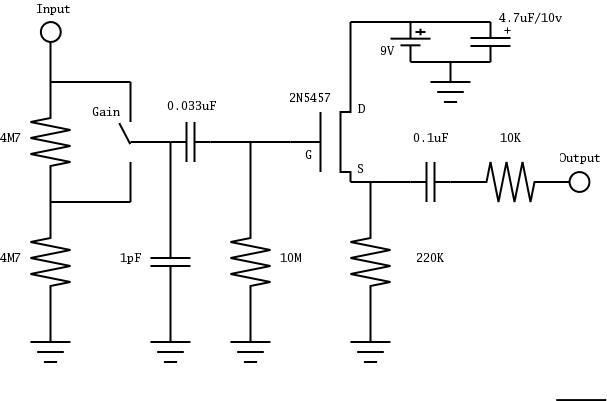> pedant!
Not at all. Capacitance always bites the highs.
I once rebuilt an oscilloscope, pots in front, amp in the rear. That minimized deflection-plate capacitance. BUT the cable from front pots to rear amp rolled-off 20KHz pretty bad at medium gains.
This may be less of an issue with guitar-range signals, and piezos. But still has to be considered.
> i've worked with video circuits too long because i am used to a standard 75R USA or 50R EURO load
Right. You think 20KHz is tough, try pushing 20MHz down a few feet of wire. In that situation, even 100 ohms of resistance is "high" compared to the pFd and MHz.
BTW: US practice includes both 50/52Ω and 75Ω systems. Short or high-power runs are often 50Ω. Cable-TV systems are universally 75Ω because it uses less copper (less cost per mile) and absolute gain flatness isn't needed (you are only looking at one 5MHz band out of the total 300MHz signal).
------------------
> how can an output have impedence since outputs are generally defined as DRIVING an impedence?
EVERYTHING has an output impedance. Look at Hoover Dam's gigantic generators: Put one light-bulb on them, and you can hardly measure the voltage drop, but hang all of Las Vegas and half of Los Angeles on them, the 10,000 volts no-load sags to 9,000 volts at (say) 9,000 Amps. Hoover Dam has an (uncompensated) output impedance of 1Ω.
Small vacuum triodes have about 10KΩ output Z. Pentodes and BJTs about 1MegΩ.
Cathode followers around 1,000Ω, emitter followers around 10Ω, BUT these things are "feedback". They self correct their output voltage. Same over at Hoover Dam: they don't let the output sag 10%, some guy (or box) turns-up the field to keep a pretty constant voltage. If done perfectly, we have 10,000V at 0A or at 10,000A, and the output impedance seems to be "zero". However this does NOT mean we can put a 100,000A or 1,000,000A load on Hoover Dam and still get 10,000V or even 9,000V: at some point you can't turn-up the field enough to hold voltage, and/or smoke starts pouring out of a million dollars worth of copper windings. (Actually, Hoover's hydro-turbines will probably slow and stop under heavy loads; not too unlike how a soft triode goes rounded.)


































